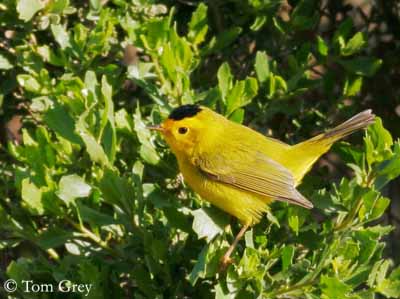
Wilson’s Warbler
Cardellina pusilla
Passeriforme Order – Parulidae Family
BIOMETRICS:
Length : 10 à 12 cm
Wingspan : 14 à 17 cm
Weight : 5 à 10 g
LONGEVITY: Up to 6 years
DESCRIPTION:
Wilson’s Warbler is a small bright olive and yellow warbler, lacking wing bars, tail pattern or streaking.
Male has a neat black “skullcap”. Female shows little or no black on crown.
Fr: Paruline à calotte noire
All : Mönchswaldsänger
Esp : Chipe de Coronilla Negra
Ital : Parula di Wilson
Nd : Wilson-zanger
Russe : Малая вильсония
Sd: Svartkronad skogssångare
Photos de Tom Grey
Son site: Tom Grey's Bird Pictures
Texte de Nicole Bouglouan
Sources:
FIELD GUIDE TO THE BIRDS OF NORTH AMERICA by National Geographic Society - National Geographic Society - ISBN: 0792274512
THE HANDBOOK OF BIRD IDENTIFICATION FOR EUROPE AND THE WESTERN PALEARCTIC by Mark Beaman, Steve Madge - C.Helm - ISBN: 0713639601
All About Birds (Cornell Lab of Ornithology)
Birds of Nova Scotia (Robie Tufts)
SORA Searchable Ornithological Research Archive (Blair O. Wolf)
What Bird-The ultimate Bird Guide (Mitchell Waite)
Wikipedia (Wikipedia, The Free Encyclopedia)

They have a thin pointed and blackish bill, with upper mandible darker than lower, yellow supercilium and underparts, and olive upperparts. Legs are pale brown. Tail is relatively long and thin. Black eyes stand out on the plain face.
Races of Wilson’s Warbler found in the East and West differ slightly in plumage, West bird being more golden underneath and more yellow above.
First year closely resembles respective adults.
VOICE: SOUNDS BY XENO-CANTO
Wilson’s Warbler’s usual call is a sharp “chip”.
Song is a rapid, staccato, chattering “chi-chi-chi-chi-chi-chet-chet”, dropping in pitch at end.
Eastern birds tend to sing a descending song, while western birds sing on one pitch, increasing in volume.
HABITAT:
Wilson’s Warbler breeds in waterside thickets, especially willows, alders or dwarf birches, streamside tangles and, in mountains, bushy hillsides or alpine meadows. In migration, Wilson’s warbler can be found in a variety of shrubby habitats, including suburban hedges and gardens.
RANGE:
Breeding range extends north to the limit of trees from Alaska to Newfoundland and Nova Scotia, and in the West, south to northern Arizona and southern California. It winters from Louisiana southward to Panama.
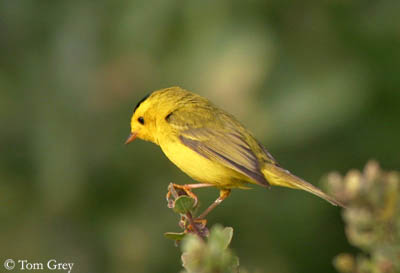
BEHAVIOUR:
Wilson’s Warbler is an active bird, often feeding high, but freely feeds in low brushy cover, and may descends briefly to the ground. It has constantly flicking wings and tail while foraging, and indulges in brief flycatching and hovering antics. It makes circular motion with tail, or wags it up and down. It often catches flying insects on the wing like a flycatcher.
Wilson’s warbler is primarily territorial and seasonally monogamous most of time. It is mostly solitary outside the breeding season, but associate with mixed flocks while foraging.
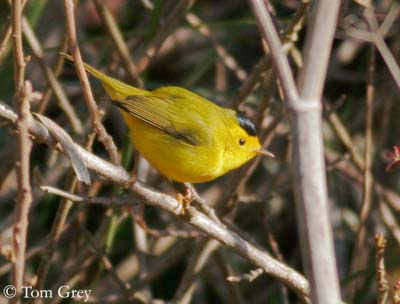
Wilson’s warbler is a migratory bird. Migration is overland and nocturnal, alone or in small groups, sometimes mixed with other species. Immature birds follow a more coastal route than adults.
Wilson’s warbler is a member of the genus “wilsonia”. This genus is composed of wood warblers with conspicuous bristles around the mouth. These bristles form a tactile-net to aid these warblers in catching insects on the wing.
FLIGHT:
Wilson’s warbler flycatches and hovers for feeding.
REPRODUCTION:
Wilson’s Warbler usually nests on or near the ground, under overhanging foliage, at the base of a shrub or clump of grass. Sometimes, in favourable habitat, nests may be so close together as to resemble loose colony.
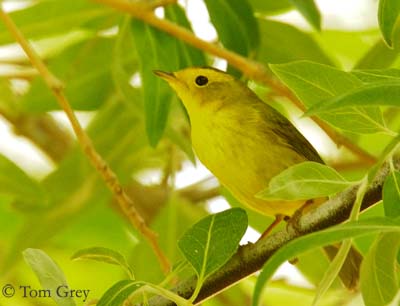
Nest is built by female. It is relatively large and bulky, made with dead leaves, rootlets and moss, shredded barks and grass, and lined with soft plant material and hair.
Female lays 4 to 6 eggs. Incubation lasts about 11 to 12 days, by female. Young fledge when they are 10 days old. One of both parents tends the fledging for several weeks.
This species produces one brood per year.
DIET:
Wilson’s Warbler feeds mainly on insects, bees, beetles and caterpillars, and spiders. Occasionally they will eat some berries.
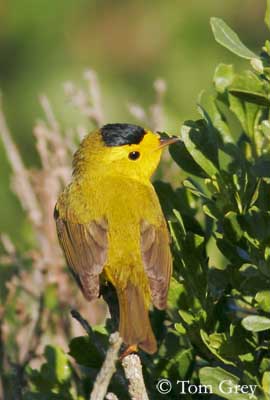
PROTECTION / THREATS / STATUS:
Parasitism by Brown-headed Cowbird can be very high on the West coast. Wilson’s Warbler populations have been declining in the West for some time, but until fairly recently, was increasing in the East.
Widespread destruction of riparian habitat on the breeding grounds is believed to be the primary threat to this species. Human disturbances, recreational activities, pesticides are other important threats.